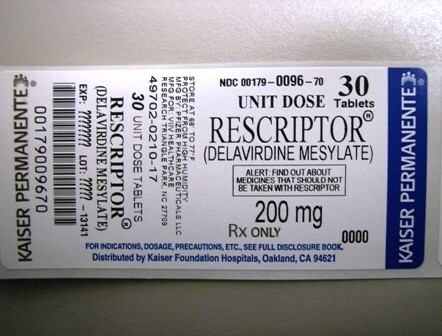Drug Nomenclature
INNs in main languages (French, Latin, Russian, and Spanish):
Synonyms: Delavirdina, mesilato de; Delavirdine Mesylate; U-90152S
USAN: Delavirdine Mesylate
INN: Delavirdine Mesilate [rINNM (en)]
INN: Mesilato de delavirdina [rINNM (es)]
INN: Délavirdine, Mésilate de [rINNM (fr)]

INN: Delavirdini Mesilas [rINNM (la)]
INN: Делавирдина Мезилат [rINNM (ru)]
Chemical name: 1-[3-(Isopropylamino)-2-pyridyl]-4-[(5-methanesulfonamidoindol-2-yl)carbonyl]-piperazine monomethanesulfonate
Molecular formula: C22H28N6O3S,CH4O3S =552.7
CAS: 136817-59-9 (delavirdine); 147221-93-0 (delavirdine mesilate)
ATC code: J05AG02
Adverse Effects
Adverse effects associated with antiretroviral regimens containing delavirdine are mostly mild to moderate. The most common adverse effect of delavirdine is skin rash, (usually diffuse, maculopapular, erythematous, and often pruritic), generally appearing within the first 3 weeks of starting therapy and resolving in 3 to 14 days. Severe skin reactions, including erythema multiforme and Stevens-Johnson syndrome, have occurred.
Additional adverse effects of moderate to severe intensity include generalised abdominal pain, asthenia, fatigue, fever, flu syndrome, headache, and localised pain.
Other reported adverse effects include gastrointestinal disturbances (diarrhoea, nausea, vomiting), increased liver enzyme values, anxiety, depressive symptoms, insomnia, and respiratory effects (bronchitis, cough, pharyngitis, sinusitis, and upper respiratory-tract infections). Liver failure, haemolytic anaemia, rhabdomyolysis, and acute renal failure have been reported during postmarketing use. Immune reconstitution syndrome (an inflammatory immune response resulting in clinical deterioration) has been reported during the initial phase of treatment with combination antiretroviral therapy, including delavirdine, in HIV-infected patients with severe immune deficiency.
Accumulation or redistribution of body fat (lipodystrophy) including central obesity, dorsocervi-cal fat enlargement (buffalo hump), peripheral wasting, facial wasting, breast enlargement, and cushingoid appearance have been seen in patients receiving antiretroviral therapy, including delavirdine.
Precautions
Delavirdine should be stopped if a severe skin rash develops or if a rash is accompanied by fever, blistering, oral lesions, conjunctivitis, swelling, or muscle or joint aches.
Delavirdine should be used with caution in patients with hepatic impairment.
Pregnancy
Delavirdine has been shown to be teratogenic in animals. Clinical studies and postmarketing data have identified 10 infants born to mothers who took delavirdine during pregnancy. Eight of the infants were born healthy, 1 infant was born HIV-positive but had no congenital abnormalities, and 1 infant was born prematurely with a small muscular ventricular septal defect that spontaneously resolved.
Interactions
Delavirdine is metabolised mainly by the cytochrome P450 isoenzyme CYP3A4. Consequently it may compete with other drugs metabolised by this system, potentially resulting in mutually increased plasma concentrations and toxicity. Alternatively, enzyme inducers may decrease plasma concentrations of delavirdine. The absorption of delavirdine is reduced by drags that raise gastric pH such as antacids and hista-mine H2-antagonists.
Delavirdine is contra-indicated with drugs that are highly dependent on CYP3A4 for clearance and for which elevated plasma concentrations are associated with serious or life threatening events. These drags include antihistamines (astemizole and terfenadine), ergot derivatives (dihydroergotamine, ergometrine, ergotamine, methylergometrine), gastrointestinal prokinetics (cisapride), antipsychotics (pimozide), and sedatives and hypnotics (alprazolam, midazolam, triazolam).
The antiepileptics carbamazepine, phenytoin, and phenobarbital, the antimycobacterials rifabutin and rifampicin, and St John’s wort decrease the concentration of delavirdine; use with the antiretroviral is not recommended due to the possible loss of antiviral activity and development of resistance. For further information on drag interactions of NNRTIs.
Antibacterials
Plasma concentrations of dapsone and rifabutin may be increased by delavirdine; rifabutin and rifampicin may reduce delavirdine plasma concentrations and the use of either of these drugs with delavirdine is not recommended.
Antivirals
Use of delavirdine with buffered didanosine may result in reduced plasma concentrations of both drugs and they should be given at least 1 hour apart; plasma concentrations of HIV-protease inhibitors including indinavir and saquinavir may be increased by delavirdine (see Antivirals, under Interactions of Indinavir) and liver function should be monitored in patients given delavirdine and saquinavir.
Antiviral Action
Delavirdine acts by non-competitive inhibition of HIV-1 reverse transcriptase; it binds to the enzyme, disrupting the conformation of its catalytic site and impairing its RNA- and DNA-dependent polymerase activity. Resistance to delavirdine and emergence of cross-resistance to other non-nucleoside reverse transcriptase inhibitors has been seen.
Pharmacokinetics
Delavirdine is rapidly absorbed after oral doses, peak plasma concentrations occurring after about 1 hour. The bioavailability of delavirdine tablets is about 85% of that from an oral solution after a single dose. The bioavailability of the 100-mg tablet can be increased by about 20% by dissolving it in water before use; the 200-mg tablets do not readily disperse in water and should be swallowed intact. Delavirdine is about 98% bound to plasma proteins.
It is extensively metabolised by hepatic microsomal enzymes, principally by the cytochrome P450 isoenzyme CYP3A4 (although CYP2D6 may play some role), to several inactive metabolites. The plasma half-life after usual dosage is about 5.8 hours and ranges from 2 to 11 hours. Delavirdine is excreted as metabolites in the urine and faeces. Less than 5% is excreted in the urine unchanged.
Uses and Administration
Delavirdine is a non-nucleoside reverse transcriptase inhibitor with activity against HIV-1. Viral resistance emerges rapidly when delavirdine is used alone, and it is therefore used with other antiretrovirals for combination therapy of HIV infection and AIDS. Delavirdine is given orally as the mesilate in a usual dose of 400 mg three times daily. Some tablet formulations may be dispersed in water before use in order to increase bioavailability (see above).
Proprietary Preparations
Australia: Rescriptor;
Canada: Rescriptor;
Mexico: Rescriptor;
USA: Rescriptor

